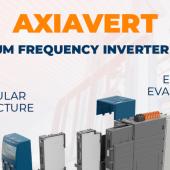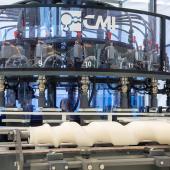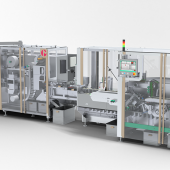Automation & Packaging
Some of the most interesting innovations and trends that emerged during two trade shows, which have borne witness to the value and the need for an ever closer convergence between the world of production and that of IT technologies. Analysis of a solid and growing sector (that of automation), the impact on the world of packaging, products and testimonies collected at the end of May by our correspondent at SPS Italia and Ipack-Ima.
Maurizio Cacciamani

Let's start from a plain fact: According to the Anie surveys, the automation market in Italy is up 13.7%, with increasingly strategic solutions and products for the transformation of the domestic manufacturing industry from a 4.0 perspective. Our analysis therefore starts from the most evident trends detected during the visit to two major industry events - SPS Italia and Ipack-Ima - to then present a selection of products and solutions that, in our opinion, best interpret the instances of innovation.
In this dossier we will focus on the news concerning components, software and systems (which readers will also find in the other pages of this issue of the magazine). Motion control, robots and AGVs will instead find space on the next issue.
Trends
• The development of sensors, fundamental element of the Internet of Things, has been impetuous. Sensor suppliers are speedily marketing so-called Smart Sensors, equipped with internal memory for data storage and communication interfaces.
A proposito di queste ultime, va detto che ogni produttore le sta integrando all’interno dei propri dispositivi, siano sensori o componenti per la pneumatica: si tratta dunque di una tendenza generalizzata, dato che tutti devono essere in grado di comunicare con tutti, anche wireless.
• With regard to the latter, whether sensors or components for pneumatics, it must be said that each manufacturer is integrating them into their own devices,: this is hence a general trend, since everyone must be able to communicate with everyone, also wirelessly.
• In order to provide complete Industry 4.0 solutions, sensor or pneumatics suppliers have also developed industrial PCs (increasingly compact) and software solutions (more or less sophisticated) for data collection and analysis.
• When we talk about data, we talk about cyber security, a subject that is much discussed not only at SPS but also at Ipack-Ima, which saw the participation of many automation suppliers. Since the safety of man and machine is put at risk by the actions of hackers, the suppliers of safety systems are integrating the part concerning data security into their solutions.
• In the field of Industry 4.0, a very popular and current theme (as also demonstrated by the number of novelties) is the convergence between production departments (OT) and management departments (IT) with solutions for scalable MES applications and solutions for data analysis ( Analytics), or that is the mobility and collaboration tools that allow departments to share knowledge and make better decisions.
• The services are becoming increasingly popular, driven by the demands of end users who require connections that allow remote monitoring, assessment of the state of the machines and devices to achieve predictive maintenance in order to avoid costly downtime.
• For the remote monitoring of machines and systems, one not only has the use of tablets and smartphones but also of mixed reality viewers (real and virtual) and the development of customizable apps.
• Transversal to all the above, the issue of security - in the broadest sense of the term safety, security, cybersecurity - is closely related to that of traceability of products and the fight against counterfeiting.
• Another interesting trend is simulation, or that is the digital twin: the machine builder, once the machine has been designed, now has all the tools to realize it as well as to test it virtually, in order to correct the errors found during the prototyping phase. With a double advantage: reduce costs but also development time.
Automation and outlet markets
The packaging machines sector is among the major consumers of components and systems for automation, of which it absorbs 10% of total turnover, second only to the food and mechanical engineering sectors (12%).
The development of the automation sector (which has not only recovered pre-crisis levels but also surpassed them, reaching almost 5 billion euros in 2017) was supported by the tax incentives contained in the Calenda plan, which helped to create greater awareness of the fact that Italian plants need to be updated in order to remain competitive. An update that cannot do without the massive application and use of automation components and systems.
The adoption of connectivity, mobility, clouds, big data and analytics is also essential for the manufacturing sector: according to a McKinsey research study of 2015, by 2025 digitization will reduce the time to market by 20-25%, optimize expertise by 45-55% and reduce the unavailability of machines by up to 50%.

COMPONENTS SOFTWARE AND SISTEMS - PRODUCT OVERVIEW
• Sensors • Safety • Pneumatics • Controls and more
Alternative to vision systems. Can optical sensors be a cost-effective alternative to vision sensors in recognizing labels on beverage bottles? The answer is yes, in the face of an appropriate downsizing of inspections, reduced down to essential information. The Balluff B0H005C optical label sensor enables detection to be obtained in a cost-effective and extremely reliable manner, also in filling processes, where monitoring of major malfunctions or errors in the application of the label is necessary.
Thanks to the use of the remote amplifier, the sensor head (now extremely small) has been reduced to the pure optical function for easy integration into existing systems. Other advantages: excellent features of functionality and readability of evaluation electronics, rapid switching between different settings and operating conditions. By precisely aligning the light beam of the emitter with respect to the label, its correct positioning can be checked.
Contactless encoder. The range of Zettler incoders was born from the need to have large internal diameter position transducers in torque engines, company represented in Italy by Servotecnica: devices for precision non-contact angular measurements, which exploit an inductive technique similar to that used in resolvers, and are designed to work in difficult environments (where the capacitive or optical encoders would be unreliable). They consist of two main parts, each one similar to a flat ring: a rotor and a stator. The stator is the only part that needs power and measures the angular position with respect to the rotor.

The main features are the absolute detection of the position on the single lap with communication protocols SSI, SPI, ASI, angular resolution is 24 bit/revolution and resistance to shock and vibration. They are available with external diameters from 38 to 300 mm in standard solution with inner hole passage from 8 to 250 mm. They are also suitable for vacuum applications.
The range of intelligent sensors has been extended. Sick enriches its product portfolio with Ranger3, a 3D streaming camera that uses laser triangulation technology for the acquisition of three-dimensional images. A new sensor with ROCC (Rapid On Chip Calculation) and 2560x832 pixel technology enables the increase of the resolution and the acquisition speed, up to 7 kHz on the whole sensor or 45 kHz in a small region.

The two families of W16 and W26 photocells are also new, equipped as standard with numerous intelligent functions: the guided sensor/reflector alignment system or blue LED emitter/receiver for optimal sensor adjustment. The TeachTurn button combines, in a single command, the immediacy of automatic regulation by means of a button with the possibility of performing a manual fine tuning through the potentiometer. The indicator with five LEDs visually shows the set working distance, for a further check of the register carried out. The constancy of the signal is guaranteed on any surface thanks to a double receiver, and the adjustable reflector version can see highly transparent, semi-transparent, transparent, opaque and reflective objects. No problem even on perforated or irregular surfaces because the blade light beam ensures an optical centering even in case of discontinuity.
Like every Smart Sensor, W16 and W26 are also connected via an IO-Link interface for the transmission of detection and service data, as well as information for process control, to the PLCs. Predictive maintenance and optimization of the systems are thus ensured, also thanks to the Bluetooth connection, which allows access to this data from any authorized mobile device.
Ultra compact scanner. Matrix 120 of Datalogic is the smallest industrial scanner available on the market with 2D imager technology, easily integrated into any type of production environment. Ideal for a wide range of data collection applications in the OEM and Manufacturing sectors, including packaging, food & beverage, label-print & apply, chemical and biomedical analysis. It is available in several models, including a WVGA sensor for standard applications, 1.2 Mpixel sensor for high-resolution barcodes, a wide-angle version for proximity reading. It is equipped with integrated Ethernet and USB connectivity.
Quality of DPM code verification. The new DataMan 8072V verifier for Cognex Direct Part Mark (DPM) code analysis enables the certifiaction of the quality and readability of DPM codes, testing their performance and comparing them with pre-set quality parameters (including optical and formatting factors that could affect legibility) and assigning a "vote" to each code to enable conformity to established standards and compliance with industrial standards. Equipped with an ultra-fast processor and a high resolution camera to read and evaluate even the most difficult codes.

Thanks to the fact that it is the only DPM code verifier with 30°, 45° and 90° illumination, DataMan 8072V carries out checks on structured, curved or even recessed surfaces, and is the only verifier available that meets ISO / IEC TR 29158 (AIM DPM)standards. The high-speed decoding capability combined with effective evaluation algorithms ensure detailed and repeatable results. In addition to the DataMan 8072 verifier, Cognex also offers a complete line for the 1D and 2D code analysis of Webscan, Inc., acquired by Cognex in 2016.
Logistical simplifications. The automatic depalletization of packages of the same shape and size, optimizes the logistics processes through dynamic loading. The O3D sensor by ifm electronics detects displaced loads and compensates for positioning errors. The position indication allows automatic depalletisation of all layers or individual packs, regardless of the palletization model. In addition to data for controlling the robot, the Ethernet process interface provides information for the material and inventory management software.
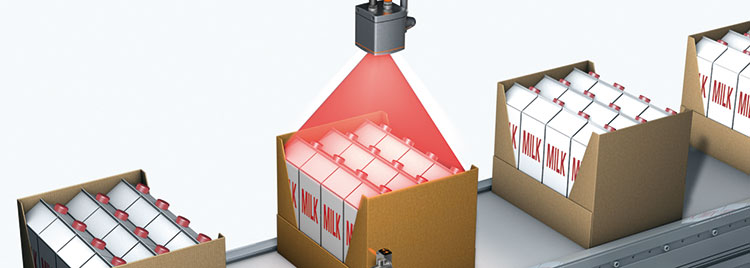
In addition to depalletizing a complete layer or individual packages, it allows the detection of interlayer, the verification of the remaining packages per pallet. Integrated collision protection and automatic calibration of the camera and robot coordinates complete the features.
1D/2D code reader. The new Keyence SR-2000 reader featues simplicity of installation and setting of the reading stability. The ultra wide field of view, the greater depth of field over longer distances, the reading of moving objects and the fully automatic calibration make the sensor ideal for many applications such as in-line reading of cardboard boxes with different heights and sizes , on lines with variable speed. A mention of the functions: verification of codes, level of correspondence, modification of data, illuminator attachment, multiple head function and consultation of statistical information. Reading with 3.1 Mpixel CMOS and configuration software complete the SR-2000.
RFID technology meets the IO-Link. From Pepperl+Fuchs three new RFID read/write heads with integrated IO-Link interface, which operate in the HF frequency range in accordance with ISO15693. Compact, sturdy and high-performance, also suitable for harsh industrial environments, the new heads support the IO-Link V1.1 standard, fast, open and compatible with future versions.
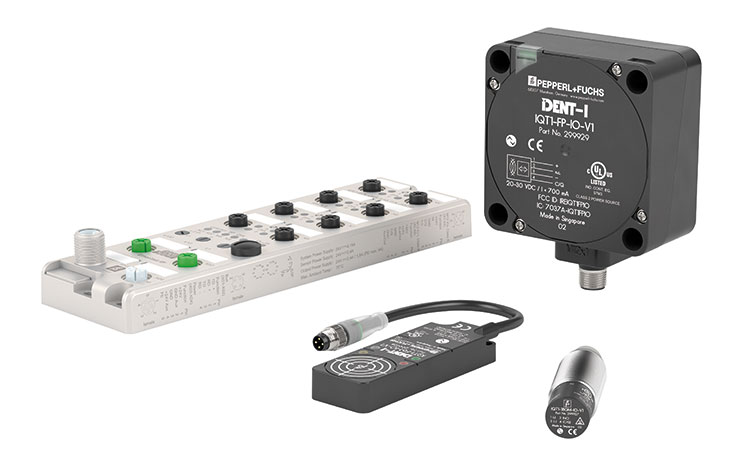
Thanks to the Easy function they are easily put into operation via plug & play without any programming activity. The automatic start function makes the new series ideal for beginners.
New generation photoelectric sensors for a smarter industry. In the new Wenglor, PNG // smart photoelectric sensors, featuring five different operating principles, the settings can be easily saved and duplicated for other applications thanks to the IO-Link interface, simplifying and speeding up the initial start-up. Monitoring of operation allows predictive maintenance. In case of replacement, the sensor configuration is automatically transferred to the new device via the data storage function. In addition to this, the clear display provided by the standard wTeach2 software allows you to combine sensors accurately in complex applications.

The sensors operate with laser, red or blue light and are factory-set to have the same switching distance when the settings are identical (potentiometer/IO-Link). Thanks to the balanced point with aligned optical axis, no subsequent realignment of the spot is necessary. The sensors, which do not affect each other when mounted side by side or facing each other, are insensitive to interfering light and are constantly in laser class 1.
There are five basic operating principles (reflection with or without background suppression, with reflector with or without transparent and unidirectional glass recognition) available in one of the smallest cases in the world (32 x 16 x 12 mm). The sensors can be linked via a connector, spiral cable or normal cable, and can be configured via potentiometer or via teach-in with the high-end variant. With a minimum weight of only 4 g, they are ideal for applications on robotic arms. IP67 / IP68 protection, well-visible LEDs and operating range from -40 to + 60 ° C complete the features..
►► SAFETY
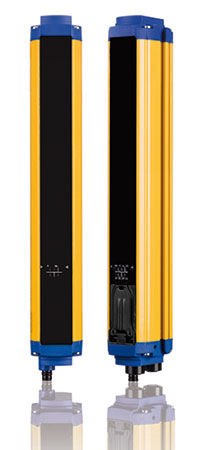 OpenSafety protocol for safety light curtain. SG4 Fieldbus by Datalogic is a safety light curtain featuring an integrated OpenSAFETY protocol over a Powerlink network. Easy to integrate into existing networks, the system communicates transparently with programmable safety controllers through an open protocol. With finger, hand and body protection resolutions, SG4 FIELDBUS represents the ideal solution for Industry 4.0 applications in a variety of industries, including food & beverage and packaging. It features reduced wiring and hardware, is easy to install and enables predictive maintenance while enhancing machine productivity.
OpenSafety protocol for safety light curtain. SG4 Fieldbus by Datalogic is a safety light curtain featuring an integrated OpenSAFETY protocol over a Powerlink network. Easy to integrate into existing networks, the system communicates transparently with programmable safety controllers through an open protocol. With finger, hand and body protection resolutions, SG4 FIELDBUS represents the ideal solution for Industry 4.0 applications in a variety of industries, including food & beverage and packaging. It features reduced wiring and hardware, is easy to install and enables predictive maintenance while enhancing machine productivity.
Safe monitoring of production areas. The safety laser scanner PSENscan by Pilz performs two-dimensional area monitoring with an opening angle of 275 degrees, a protected field range of up to 5.5 meters and a warning field range of up to 40 meters. Thanks to the free configuration of warning fields and protected fields, plus the ability to adapt to structural conditions, the safety laser scanners can be integrated into a diverse range of applications. The operator display provides information directly to the user. Retrievable data storage makes it possible to transfer configuration at any time. In combination with the configurable PNOZmulti safety system or the programmable PSS4000, the PSENscan safety laser scanner offers an effective, complete and flexible solution.
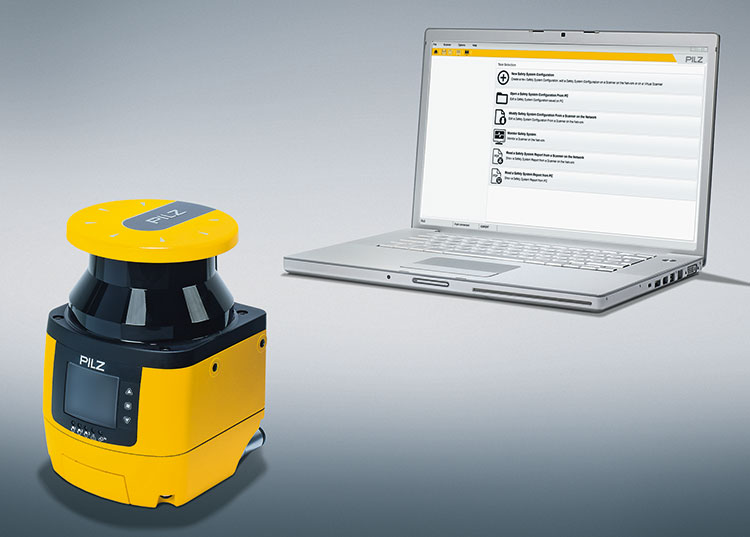
►► PNEUMATICS
Multitech approach. Camozzi solutions employ pneumatic, proportional and electric technologies to control every application in the most effective and efficient possible way.
The firm’s pick & place station changes the format of two types of bottle, differing in size and height, using a self-centering parallel gripper with T guide. Vertical motions are performed by means of a positioning feedback cylinder actuated by a digital proportional valve for master position control and a digital proportional valve for flow control (slave).
Horizontal motion is performed by an electromechanical axis with step motor controlled by the new DRCS drive. When in motion, the station is actuated by an electromechanical axis with brushless motor and drive for the DRWB brushlesss motor to move the bottles to set positions in at each station. The “closure/capping” station simulates screwing (capping) and unscrewing of the cap. An electronic pressure switch and vacuum switch control blowing pressure for expelling the cap. Vertical motion is performed by an electromechanical cylinder with a step motor controlled by the new DRCS drive. The screwing/unscrewing process is performed by a brushless motor that controls the torque.
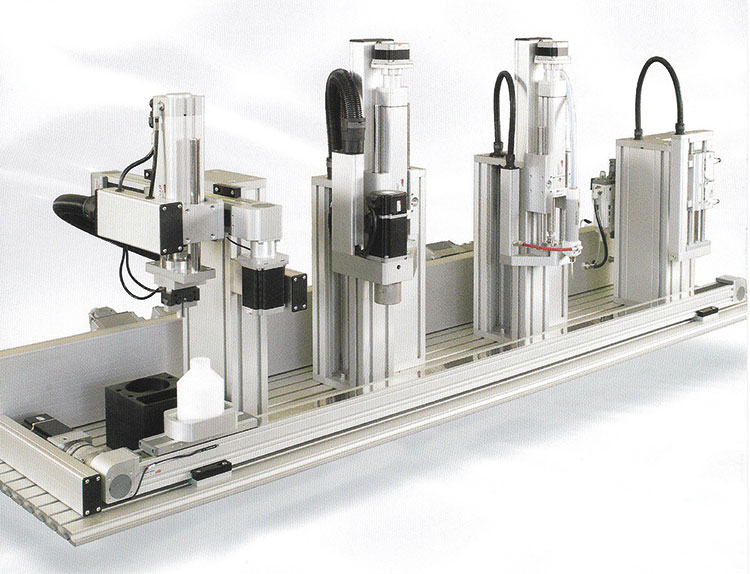
Filling is performed at the filling station, preventing foaming (quick drop and controlled rise) using a dosing valve driven by an electromechanical cylinder with step motor controlled by the new DRCS drive. Two vacuum/pressure switches control the pilot pressure for reducing liquid and filling/dosing pressure.
At the “leak control” station, seal testing is conducted using two pressure/vacuum switches controlling the closure and test pressure, respectively. The pressure/vacuum switches are controlled by two electronic proportional micro-regulators. The motion is generated by a cylinder with integrated guide. The air used to feed all stations is filtered by an FRL unit. A PLC controls the entire system, including valves linked to a local Profinet network.
The machine is linked to the Camozzi Digital cloud software platform, which analyzes and controls the functioning conditions of every station.
Interfaceable with all major communication protocols. Pneumax Series 3000 solenoid valves feature a compact, 10 mm linear design and a range of 200 Nl/min. They are available in single, manifold, multipolar and series versions. The series, which interfaces with all major communication protocols, is complemented by a wide range of input modules.

Pneumax has also launched the new 1800 series of electric cylinders, featuring stern travel through recirculating ball grubscrew transmission, which converts the rotary motion of an electric motor (step or brushless) into linear motion. Main features: management of variations in speed and acceleration/deceleration, positioning and transitional tracks with high precision positioning repeatability, thrust control, setting dimensions in compliance with ISO15552.
Signals management. SMC presents the new EX600 Wireless system for managing digital, analog and pneumatic signals. When using remote peripherals linked up to one another through the various industrial networks (Profinet, Ethernet-IP, EtherCAT, Powerlink, CC Link IE, etc.), connection failures and/or damage to link cables is a common issue, resulting in costly and frustrating machine stops. Such events can pose a serious criticality, especially when peripherals are installed on mobile equipment (robots, turntables, etc.).
The SMC solution makes it possible to avoid not only disconnected cables, but also to eliminate general wiring costs and accessories (sliding rotating joiners, specific connectors for fieldbus applications).

EX600 Wireless features master/slave type flexibility. Each master unit can be linked to up to 128 slaves, wirelessly, using the frequency range reserved for industrial communication (2.4 GHz – ISM; 79 channel spectrum) with 5 ms refresh, ensuring stable and reliable industrial communication even in case of disturbances or interference.
Each master unit manages up to 1280 I and 1280 O units, combining digital, analog and pneumatic ones, distributed among those integrated with the network.
The system’s modularity also makes it possible for each master or slave unit to manage relevant signals using digital input/output modules (connection: M8-M12-D Sub, Cage Clamp), analog input/output modules (range mA-MV) and pneumatic subbase (manifold valves: SY, SV, VQC).
The Web-Server function makes it possible to monitor communication through modules (channels, frequencies, etc.) with the possibility of retrieving detailed log-files in Excel format.
Additionally, the new system (which is IP67) offers data cryptography to safeguard the security of machinery and equipment on which it is installed. Other features include 24 Vc.c. power and advanced diagnostic functions (hardware and software) that are compatible with Ethernet-IP and Profinet communication protocols.
Industrial software and PCs. Dal concept alla macchina funzionante e ottimizzata grazie al prototipo virtuale. Funzionalità sempre più complesse nell’automazione di macchina e una crescente richiesta di personalizzazione si scontrano oggi con l’esigenza di ridurre i tempi di realizzazione e collaudo di ogni macchina, qualunque sia la configurazione. Da qui la necessità di pensare a modalità di sviluppo nuove, che permettano di superare la classica pocedura: progetto-prototipo-test-correzione-riprogettazione, dispendiosa in termini di costi e di tempi.
Le fasi di prototipazione e test su macchine fisiche possono ora essere effettuate virtualmente, dove una macchina, o una parte di essa, viene rappresentata da un modello matematico che ne replica fedelmente il funzionamento. Il modello viene poi codificato e, nell’architettura B&R, integrato direttamente all’interno dell’ambiente software di sviluppo Automation Studio. In questo unico ambiente è possibile scegliere, in base al carico meccanico, azionamenti e motori, simulandone la dinamica, grazie all’utilizzo di pochi blocchi funzione pronti all’uso.

In such a way, the designer of the software application and the designer of the mechanics can verify the system’s general behavior before producing any physical parts in the workshop. This makes it possible to experiment with the physical design of the machine using sophisticated control algorithms in a secure virtual environment.
Any mechanical, electrical or logistical criticalities are clearly evident in the simulation for easy correction, thereby improving the design as needed, with no additional cost for mechanical execution, except for the definitive prototype and without putting people or machinery at risk.
The simulation makes it possible to verify the dimensions of each moving part, refining the measurements of motors involved in order to optimize the investment. The goal is to combine the automation parts by starting from the PLC and motion system, in which the simulation tools ARSim and SimACOPOS are directly integrated into the B&R control system, with the physical model of the mechanical components and machines, where the models are made using software tools like Simulink or MapleSim, through to the level of plant and process, at which point tools like IndustrialPhysics come into play.
Once this stage has been completed, it is possible to proceed to simulation of the entire machine, which, thanks to virtual prototyping proper, is tested as a whole and finally completed in the office, before setting foot in the workshop.
MindSphere: flexibility, reduced time-to-market, efficiency and quality. Siemens is working to assist the digital transformation of manufacturing and processing operators and support them in implementing digital enterprise solutions. MindSphere – already available on Amazon Web Services (AWS) – is a Platform as a Service (PaaS) that makes it possible to develop, use and supply digital services and applications for industry. With this cloud-based, Internet-of-Things-ready operating system, users can perform comprehensive analysis of the raw data produced by machines, stations and factories with the help of a wide range of apps that can be purchased on AWS. However, anyone can develop their own apps and make them available on AWS as well.
Connecting to MindSphere makes it possible to collect and monitor data directly from the machine in order to assess remotely availability and productivity in real time and plan predictive maintenance, eliminating machine downtimes.
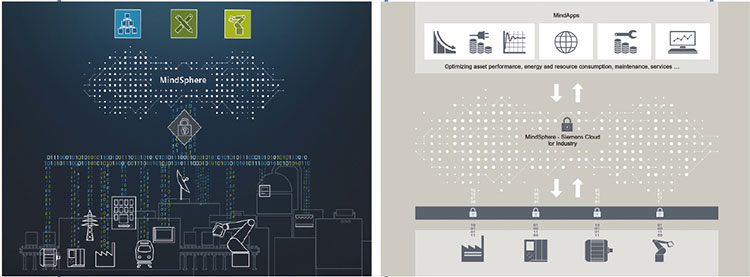
Greater flexibility, shorter time-to-market, enhanced efficiency and quality: these are some of the advantages offered to Siemens users. The company aims to further expand its offer with solutions capable of optimizing performance and productivity. Among others, already in the works are digital twins, for creating a holistic virtual model of the value chain (of a physical product, a line of products, a production process or an entire factory).
Associazione MindSphere World. Recently founded, in Germany, the global organization of Siemens partners has set itself the goal of expanding the basic ecosystem, promoting research and development as well as training in the MindSphere environment, as well as codifying uniform user data use rules. A corresponding user organization will presently be established in Italy as well.
Gathering data from a variety of sources. Rockwell’s ThinManager Rockwell isolution retrieves data in real time from various sources, including video cameras, PC desktops, SCADA app clients or operator panels, and sends them to a thin client terminal that summarizes them in a comprehensive display, subdivided into various panels, each one corresponding to a different data source. This summary can be accessed via stationary terminals or mobile devices (tablets, smartphones or VR devices like Microsoft’s HoloLens). When using mobile devices, it is also possible to set to mobile mode, enabling the operator to, for example on a line with four stations with PLC, configure a data display that changes in accordance with the operator’s own proximity to one of the stations.
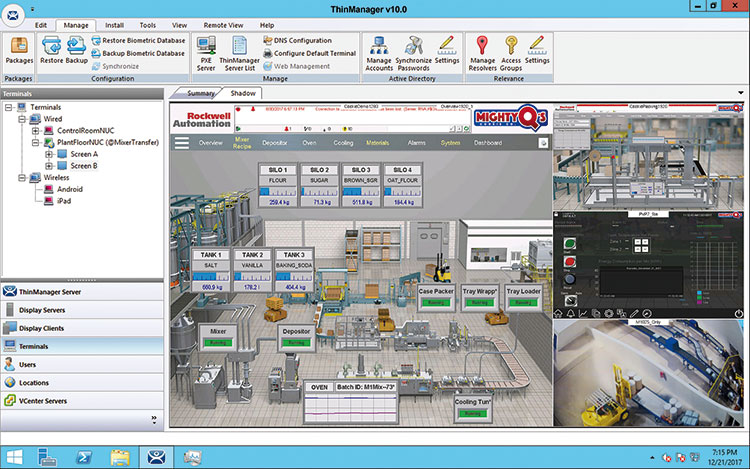
Using HoloLens, on the other hand, data can be displayed so that it changes according to the application toward which one is facing. Then there is the FactoryTalk Analytics Platform, a new scalable analytics platform for industrial IoT applications that enables a manufacturer to access data useful in a given place and time, enabling correct decision-making in a timely fashion. The platform provides access to specific analytics and supports advanced analysis based on data (structured and otherwise) retrieved from any existing data source. It can also intelligently associate corresponding data by generating intuitive dashboards that users can share and display. Users can also perform deep analysis operations to support an enhanced decision-making process, with a significant reduction to analysis time.
FactoryTalk Analytics for Devices helps the user avoid costly machine stops and enhance productivity by enabling them to identify device health status in advance. The smart device, following simple linkup to the power supply and local system control network, can supply analytics in just minutes. Production teams can then access specific calls-to-action in real time, as well as diagnostic pages for single devices, all available within the software.
The interaction possible with SAP. Thanks to the shop floor integration (SFI) software offered by GIB, a new IFM group company, data exchange between SAP and the complex world of sensors, controllers and machines is now possible. Using personalizable rules, the system enables users to process and transmit machine events and relevant process information from the source to a linked SAP system. With minimal integration efforts, follow-up activities can be started and controlled automatically to create a reactive and automated supply chain process. The software offers advantages including: production data analysis in SAP in real time, the possibility of activating models preconfigured in SAP for subsequent activities instigated by sensors, predictive maintenance, reduced spare parts stock and coordinated maintenance and production activities.
Cloud connection reachable with tablet. Digital transformation will make it possible to create flexible machinery that is easy to update in accordance with product demand. Hence the necessity of having machines that are linked up together, on which expert operators can make modifications quickly and with ease. It becomes essential, however, to monitor processes and facilitate effective maintenance that reduces machine stops to the minimum.
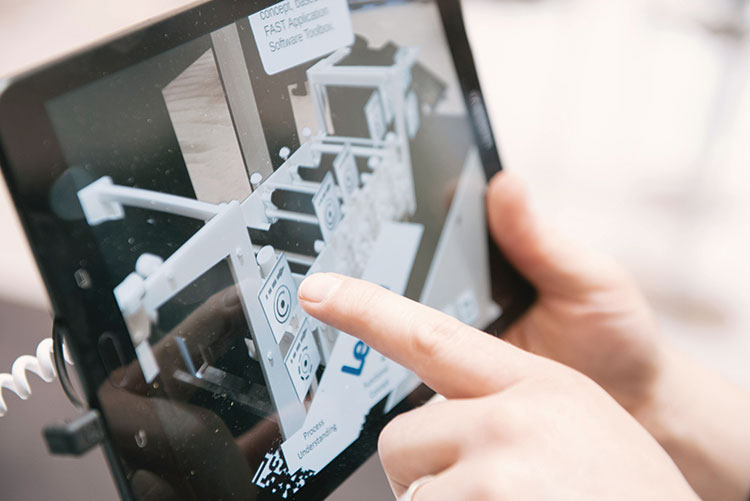
Another essential requirement is security, not only of the operator and the machine, but also of the data processed. A prerequisite for digital machines is nonetheless communication of its performance in a simple and secure fashion. With its open digital platform, Lenze guarantees this communication by means of universal standards like OPC-UA and MQTT, which enable the user to transfer data to the cloud and/or directly to a tablet without the need for dedicated programming. The first step for Lenze was the development of Plant Management and Remote Predictive Maintenance in maximum security, soon to be followed up with a Digital Twin application.
Operational awareness in real time is a competitive advantage.
The platform EcoStruxure Machine Advisor di Schneider Electric offers the possibility of enhancing efficiency by converting data into knowledge. This represents a fundamental issue for OEMS, which, with remote real-time access to their systems, can add new services and perform modifications at any production site across the globe. The platform features three key functionalities:
- Tracking. OEMs can visually display the position of all machines, accessing any accompanying documentation and archives in real time – product info, manuals, maintenance logs and task management programs;
- Monitoring. The cloud-based software enables users to gather data from machines and visualize it in real time, using tools like complete OEE analysis, widgets for comparing performance with key KPI, trend analytics, and operational dashboards for monitoring machine availability and output quality);
- Maintenance. Activated through a mobile app, this function facilitates maintenance and operations by supplying contextual information using guides that describe step-by-step procedures and the possibility of remotely contacting expert support, making use of augmented reality technology. Furthermore, the maintenance module offers remote access to engineering software in the cloud, so that service technicians can always access the right version and the right libraries, thanks to the availability of this software as a service.
EcoStruxure Machine Advisor carries immediate advantages for machine operators as well, thanks to the EcoStruxure Augmented Operator app, which makes information available in real time wherever and whenever needed. The personalized application enhances operator efficiency using augmented reality, so that the operator can superimpose up-to-date data and virtual objects on their actual vision of a frame, a machine or an installation.
Controlling production goals. InTouch by Wanderware is more than a graphic display: the application developer can focus on content that fosters plant productivity and cost-saving, enabling operators to optimize routine interactions with industrial automation systems. Situational awareness graphic object libraries supply contextualized information with which the operator needs to respond quickly and accurately to anomalous situations before they impact production. These are the salient characteristics and advantages of this system: quality graphics and preset graphic icons that are ready to use; facilitated real-time decision-making; enhanced operational and engineering productivity, with accelerated operator learning curve; secure access to the IT system from any device, anywhere, anytime.
►► CONTROLS AND MORE
The importance of control. Interroll MultiControl is a network card for control and integration of the Roller Drive by Interroll in numerous transport system applications, such as static pressure conveyors, roller curve conveyors, advancement conveyors with no zone division and 45 or 90 degree unloading units like Interroll High Performance Divert (HPD).
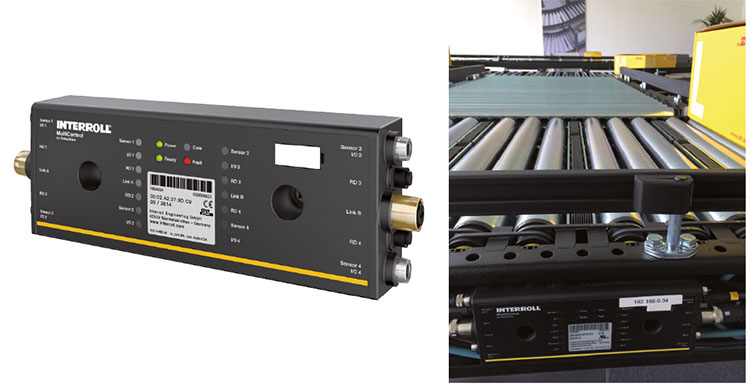
Real-time communication over Profinet, EtherNET/IP or EtherCAT is possible simply by setting each MultiControl unit, which can be used at temperatures ranging from -30 to +40 degrees Celsius.
Where needed, plug & play connection enables quick and easy replacement, with no need for orientation or configuration. Then there are DriveControl command modules, universal interfaces for Roller Drive, and ZoneControl, a 1-zone control unit for the Roller Driver for use with non-static pressure conveyors not requiring the use of a superior control unit.

The first controller featuring PLCnext Technology is ready. Phoenix Contact launches on the market its new AXC F 2152 controller, the first to be based on revolutionary PLCnext Technology, the innovative open control platform that makes it possible to program control systems using established software tools (Visual Studio, Eclipse, Matlab Simulink and PC Worx) and use different programming languages within the same project.
These capabilities facilitate the parallel work of multiple developers with competencies in different programming languages.
A fundamental component of the solution is the adaptive PC Worx Engineer design software, which also supports programming in accordance with IEC 61131-3, as well as configuration, diagnostics and visualization of the entire system in a single program.
The design platform is characterized by a simple and intuitive interface, but also a modular structure that enables the user to add individual modules to the free-to-use basic version as needed. The possibility of adding reusable automation modules and the support of safety and security functions reduces development timeframes.
Ultra-compact industrial PC. Not a brand new product but nonetheless deserving of note due to its compactness, Advantec is probably the smallest industrial PC in the world (UNO-22171G), measuring just 100 x 70 x 30 mm. Its CPU is an Intel Atom E3814 featuring 46 GHz, 4 Gbyte RAM DDR3L, HDMI port for monitors up to 1920x1080 pixels, 2 Ethernet ports, 1 USB, 32 Gbyte eMMC memory (mSata on request), 1 slot full size mPCIe and PCLe 2.0 expansions,
Router for tele-assistance. Efa, which distributes Ewon brand products in Italy for the Swedish HMS, presents Cosy (Communication made eaSY), an industrial tele-assistance router which enables effecting secure connections thanks to double Ecatcher authentication, a free Talk2M VPN client that guarantees secure access to the HMI and SCADA dashboards via smartphone, tablet or PC through the M2web portal. The router also features compatibility with the main PLCs on the market, easy guided setup of the outgoing firewall connection, integrated wifi, protected connectivity, the separation of lan and business networks, Nat 1:1 for communication with SCADA and MES, an SD card, USB connectivity and a connection trial audit service.











